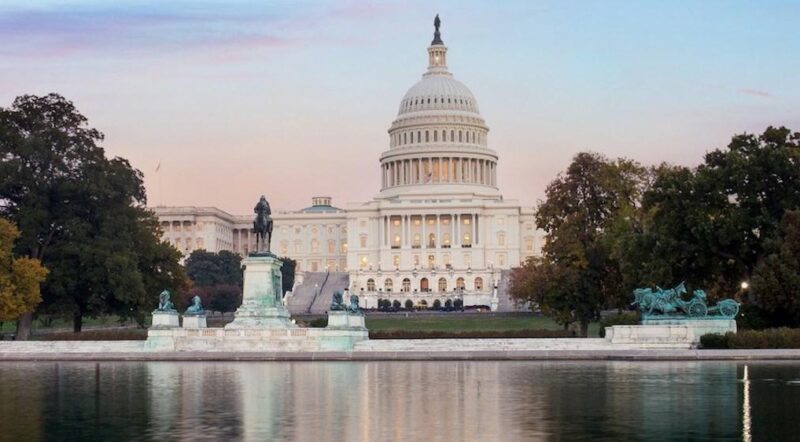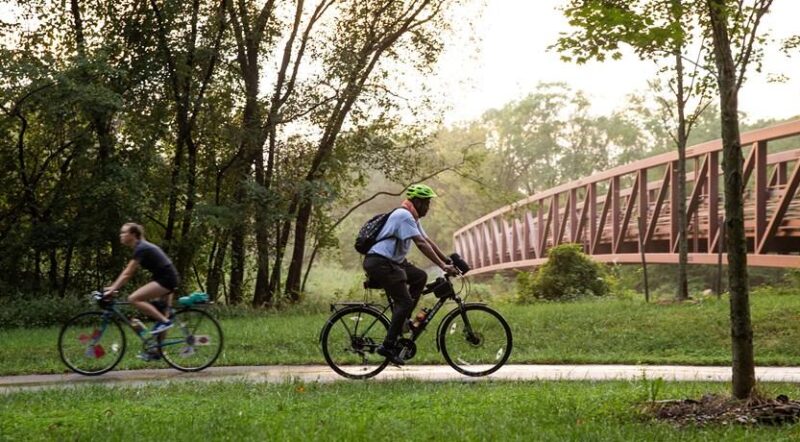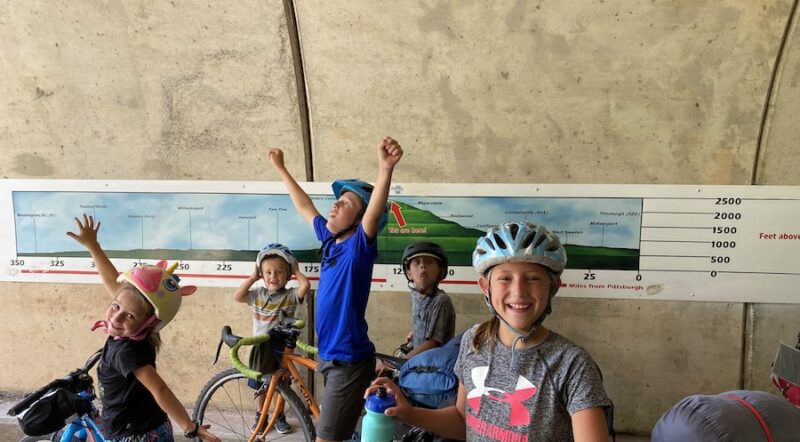RAISE Frequently Asked Questions (FAQ)
Photo courtesy Getty Images
Rebuilding American Infrastructure with Equity and Sustainability (RAISE) Grants Frequently Asked Questions
The United States Department of Transportation (USDOT) released their Notice of Funding Opportunity (NOFO) for their Rebuilding American Infrastructure with Sustainability and Equity (RAISE) grants. RAISE is a competitive, merit-based grant program open to all surface transportation projects that advance national priorities. Since this grant program is open to all surface transportation types, it is highly competitive; only 1 in 10 applicants were chosen in 2021.
Rails-to-Trails Conservancy (RTC) wants to make sure you have all the information you need as you consider whether this funding program is right for your trail and active transportation project. After you have looked over the NOFO, we encourage you to browse our answers to your frequently asked questions about how this grant can be used for your projects.
If you do decide to apply for a RAISE grant, either in this round or in the future, please read the entirety of the USDOT’s NOFO and register for, or watch recordings from, the USDOT’s webinar series for application assistance.
If you are thinking of applying for a RAISE grant, or have already applied, we would love to hear about it! Please contact us with any information or additional RAISE-related questions for your trail and active transportation projects. For specific application questions, please visit the USDOT’s RAISE page or email them at RAISEgrants@dot.gov.
What are RAISE grants?
The Rebuilding American Infrastructure with Sustainability and Equity (RAISE) Grants are a continuation of the U.S. Department of Transportation’s (USDOT’s) multimodal and multijurisdictional competitive grant program formerly known as both TIGER and BUILD. In 2021, the first cycle of RAISE grants saw nearly $1 billion awarded to 90 surface transportation projects in 47 states, the District of Columbia and Guam for projects meant to improve infrastructure and supply chains, increase safety and equity, and combat climate change.
What basic information should I know about FY 2022 RAISE grants?
- Applications are due by 5 p.m. EDT on April 14, 2022. If this is your first time applying via Grants.gov, you must register, and registration can take between two and four weeks. The USDOT also encourages applicants to submit materials up to one week in advance to avoid any technical issues.
- $1.5 billion available for FY 2022; up to $75 million for eligible planning and preconstruction
- Funding split evenly between urban and rural projects
- Eligible cost share/match:
– Federal cost shares of up to 80% in urban areas and up to 100% in rural areas, Areas of Persistent Poverty, and/or Historically Disadvantaged Communities
- Award Sizes:
– Minimum award size of $5 million for projects in urban areas and $1 million in rural areas
– Maximum award size of $25 million per project and $225 million per state
What merit criteria will be used to evaluate my application?
The merit criteria review will be based on the following:
- Safety*
- Environmental sustainability*
- Quality of life*
- Mobility and community connectivity*
- Economic competitiveness
- State of good repair
- Partnerships and collaboration
- Innovation
Each merit criterion will be given its own rating; the merit criteria ratings will inform one overall merit rating to determine if your project will advance in the competition. Note that the starred (*) criteria will take priority in the overall merit rating.
Why should I consider RAISE grants to help fund my trail or active transportation project?
The most attractive aspect of this program in any funding cycle is the opportunity to secure a large grant (up to $25 million) to pursue a complex project or multi-segment network. Many localities also see an advantage in applying directly to the USDOT.
This year’s round of RAISE grants promises to be the best chance yet to secure big investments for trail and active transportation networks because: 1) the criteria for selecting projects—such as safety, equity and climate—have become more favorable to active transportation; 2) the USDOT awarded over 40% of funding to trail and complete street projects in 2021—an unprecedented share of overall funding in the history of the program; and 3) thanks to supplemental funding included in the Bipartisan Infrastructure Law (BIL), the available funding for FY 2022 RAISE grants has increased by 50% to $1.5 billion. Additionally, depending on the outcome of the FY 2022 appropriations process, significantly more funding could be forthcoming.
How do I know if my trail or active transportation project will be competitive for a RAISE grant?
You should first consider whether your project aligns well with the listed merit criteria. Meeting these criteria will help demonstrate that the project’s benefits outweigh the costs. The USDOT has provided a rubric on page 41 of the NOFO to outline how they will measure and score each criterion. Keep in mind that the safety criterion supports actions and activities identified in the USDOT’s National Roadway Safety Strategy Plan released in January 2022. Safety, equity, climate and job creation are core values for the administration and should also be the focus of your application narrative.
While your project may closely align with the criteria, the USDOT is looking for clear, credible and data-driven evidence to back up the benefits. Additionally, they are looking for projects that display a high level of readiness in terms of environmental permitting, feasibility and capacity to deliver on the project, and whether you can show financial completeness (readiness to obligate funds by Sept. 30, 2026).
How can I best demonstrate the demand and benefits for my capital trail or active transportation project?
A benefit cost analysis (BCA) will be part of your capital planning application, and the USDOT will use it to evaluate your project. The USDOT’s 2022 Benefit Cost Analysis resources have yet to be released at the time of this writing, but we recommend that you watch a recording of the USDOT’s 2021 Benefit Cost Analysis (BCA) webinar to best understand what data points they are looking for so you can begin sourcing the information needed. Note that a BCA is not a part of planning grant applications.
If you have the capacity, it may be beneficial to source out the BCA or make sure that you have the appropriate technical team in place with the skills and resources needed for its compilation. However, this is not always feasible due to cost and staff capacity limitations. Contact your local metropolitan planning organization (MPO) or state department of transportation, and look online to see if they have any available resources, such as GIS databases, containing the necessary information.
I want to submit a trail or active transportation application, but I’m worried that we cannot meet the local match requirement. How is the USDOT addressing this for projects in smaller or under-resourced communities?
Under the Bipartisan Infrastructure Law (BIL) signed in November 2021, the number of communities eligible for a 100% federal share of funding in RAISE was expanded. Specifically, communities considered rural, in Areas of Persistent Poverty, and Historically Disadvantaged communities can qualify for up to 100% of the federal share of funding. To help reach this goal, the USDOT launched a tool for FY 2022 to allow applicants to determine if their project location is considered a Historically Disadvantaged Community.
You can determine whether your project is considered rural or urban based on 2010 U.S. Census Bureau information. A project located in an Urbanized Area with a population greater than 200,000 is considered urban, while all other project areas (those located outside of an Urbanized Area, in an Urban Cluster or in an Urbanized Area with a population less than 200,000) are considered rural.
Does this program apply to stand-alone trails, or does it apply only to trail networks?
Applications can be submitted for standalone trail projects, trail networks or trails that span multiple states or jurisdictions. We encourage you to consider how your project, standalone or part of network, aligns with the merit criteria in the rubric to be most competitive.
For applications with multiple components, you should demonstrate how they relate to each other. The USDOT also strongly encourages that you detail the costs and requested RAISE grant funding for each component, as well as the overall RAISE grant funding request.
My trail or active transportation project spans multiple counties or states and several census tracks. How do I know if my project is considered urban or rural, or whether the project is considered an Area of Persistent Poverty or Historically Disadvantaged Community?
For projects where expenditures are in both urban and rural areas, the USDOT will designate projects based on where most of the project funds will be spent.
The same is true for projects that span multiple census tracts or counties; the designation will be based on where most of the project costs will be focused.
My project spans multiple states or jurisdictions or is part of a larger collaborative effort. Am I eligible to apply? Are nonprofit organizations and MPOs eligible to apply?
All public entities are eligible to apply. While nonprofits are not eligible on their own, they can partner with an eligible project sponsor.
If you are applying for multiple states or jurisdictions, you will need to specify a lead applicant that will serve as the primary point of contact and recipient of the award. You will also need to include a description of the roles and responsibilities of each applicant.
What other tips do I need to know?
This past February, RTC hosted a webinar with panelists made up of successful FY 2021 RAISE grant recipients, including: Sara Maier, Cleveland Metroparks’ principal planner; Lonny Boring, St. Louis, Missouri’s Great Rivers Greenway senior project manager; and Ned Barret and Pat Votava, who played key roles in the successful application for the Spartanburg County Multi-Modal Project in South Carolina.
We encourage you to watch the recording of this webinar on our webinar archive page to hear their inside tips, including how they gathered local and political support and how they determined if their projects would be competitive, and the resources and data they used to put their applications together.
RTC has also compiled a list of FY 2021 RAISE trail projects—including links to any available application narratives—that you can browse as you determine if you want to pursue this federal funding opportunity for your project.
RAISE grants may not be the right funding program for my project, or I have been rejected to receive a RAISE grant, but I want to explore other federal funding opportunities. Where can I find more information about available opportunities?
While RAISE is a great opportunity to secure big investments for your trail and active transportation projects, it is important to remember that the grants are highly competitive, and there is a maximum amount of funds that can be received in each state. We encourage you to save your application materials and incorporate feedback from the USDOT to try for subsequent rounds of this grant program. You may end up receiving one in the future, or you can use your materials for other funding opportunities.
You can visit our Public Funding for Trails and Active Transportation page to find other funding opportunities available for your project, such as the Recreational Trails Program, which is administered at the state level, and the Transportation Alternatives program, which is administered at both the state and MPO levels. You will also find information about a new discretionary funding program authorized by the BIL and specifically meant for projects that connect active transportation networks: the Active Transportation Infrastructure Investment Program. RTC is working with advocates to secure full funding of the program at $500 million in the FY 2023 appropriations process and beyond. Stay tuned for more information about this program and upcoming advocacy opportunities.
RAISE Stories
View More Blogs
What the 2024 Election Means for Active Transportation

Federal RAISE Grants Illustrate Widespread Demand for Infrastructure That Makes It Safer and Easier to Walk and Bike in Communities Nationwide
